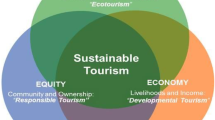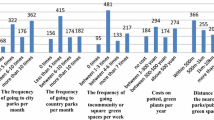Abstract
The investigation of subjective well-being with the aim of steering tourism development towards improving host community well-being in World Heritage Sites is the principle behind Planet Happiness project. To complement the extant literature on the Happiness Index’s use in different national contexts, this research outlines a methodological approach of the translation and localization of Happiness Index to Turkish language and cultural characteristics. Subsequently, additional items derived from scholarly literature to capture residents’ perceptions of conservation efforts and tourism activity are proposed. Reinforcing these theoretical findings with insights of polling firms and through interviews with experts working in World Heritage Sites, this research suggests that well-being studies would benefit from a modular perspective that allows the reflection of contextual elements in the survey instrument and in the data collection process that are rooted in the geographical, legal, economic, and socio-cultural attributes of the region or city in question. This methodological approach is tested in Cappadocia World Heritage Site in Turkey with 178 respondents chosen via convenience sampling. The findings of descriptive statistical procedures indicate a contextual incompatibility of several items of the Happiness Index in Turkey and suggest that future inquiries into subjective well-being would benefit from context-specific modifications to the Happiness Index. By combining well-being with findings pertinent to additional tourism and conservation domains, the methodological implications for future well-being studies in Turkey’s World Heritage Sites are discussed.
Similar content being viewed by others
References
Andereck, K. L., Valentine, K. M., Knopf, R. C., & Vogt, C. A. (2005). Residents’ perceptions of community tourism impacts. Annals of Tourism Research, 32(4), 1056–1076.
Brislin, R. W. (1970). Back-translation for cross-cultural research. Journal of Cross-Cultural Psychology, 1(3), 185–216.
Buhalis, D. (2000). Marketing the competitive destination of the future. Tourism Management, 21, 97–116.
Caner, A. (2014). Happiness, comparison effects, and expectations in Turkey. Journal of Happiness Studies, 16(5), 1323–1345.
Corburn, J. (2003). Bringing local knowledge into environmental decision making - improving urban planning for communities at risk. Journal of Planning Education and Research, 22, 420–433.
de Leeuw, E. D., Hox, J., & Huisman, M. (2003). Prevention and treatment of item nonresponse. Journal of Official Statistics, 19(2), 153–176.
Diener, E., Ng, W., Harter, J., & Arora, R. (2010). Wealth and happiness across the world: Material prosperity predicts life evaluation, whereas psychosocial prosperity predicts positive feeling. Journal of Personality and Social Psychology, 99(1), 52–61.
Dumludag, D., Gokdemir, O., & Giray, S. (2015). Income comparison, collectivism and life satisfaction in Turkey. Quality & Quantity, 50(3), 955–980.
Ekici, T., & Koydemir, S. (2013). Social capital, government and democracy satisfaction, and happiness in Turkey: A comparison of surveys in 1999 and 2008. Social Indicators Research, 118(3), 1031–1053.
Eren, K. A., & Aşıcı, A. A. (2016). The determinants of happiness in Turkey: Evidence from city-level data. Journal of Happiness Studies, 18(3), 647–669.
Firth, T. M. (2011). Tourism as a means to industrial heritage conservation: Achilles heel or saving grace? Journal of Heritage Tourism, 6(1), 45–62.
Florek, M. (2011). No place like home: Perspectives on place attachment and impacts on city management. Journal of Town & City Management, 1(4), 346–354.
Harrill, R., & Potts, T. D. (2003). Tourism planning in historic districts: Attitudes toward tourism development in Charleston. Journal of the American Planning Association, 69(3), 233–244.
Helliwell, J. F., Layard, R., & Sachs, J. D. (Eds.). (2019). World happiness report 2019. New York: Sustainable Development Solutions Network.
Human, H. (2015). Democratising world heritage: The policies and practices of community involvement in Turkey. Journal of Social Archaeology, 15(2), 160–183.
Istanbul Site Directorate. (2018). İstanbul Tarihi Yarımada Yönetim Planı (Istanbul Historical Peninsula Management Plan). Istanbul: Istanbul Büyükşehir Belediyesi.
Jimura, T. (2011). The impact of world heritage site designation on local communities – A case study of Ogimachi, Shirakawa-mura, Japan. Tourism Management, 32(2), 288–296.
Joy, C. (2016). ‘Enchanting town of mud’: Djenné, a world heritage site in Mali. In F. De Jong & M. Rowlands (Eds.), Reclaiming heritage: Alternative imaginaries of memory in West Africa (pp. 145–159). London: Routledge.
Kahneman, D., & Deaton, A. (2010). High income improves evaluation of life but not emotional well-being. Proceedings of the National Academy of Sciences, 197(38), 16489–16493.
Kim, K., Uysal, M., & Sirgy, M. J. (2013). How does tourism in a community impact the quality of life of community residents? Tourism Management, 36, 527–540.
Lankford, S. V., & Howard, D. R. (1994). Developing a tourism impact attitude scale. Annals of Tourism Research, 21(1), 121–139.
Lawson, R. W., Williams, J., Young, T., & Cossens, J. (1998). A comparison of residents’ attitudes towards tourism in 10 New Zealand destinations. Tourism Management, 19(3), 247–256.
Lee, S., Liu, M., & Hu, M. (2017). Relationship between future time orientation and item nonresponse on subjective probability questions: A cross-cultural analysis. Journal of Cross-Cultural Psychology, 48(5), 698–717.
Milman, A., & Pizam, A. (1988). Social impacts of tourism on Central Florida. Annals of Tourism Research, 15, 191–204.
Ministry of Culture and Tourism (2019). Konaklama istatistitleri (Accommodation statistics). https://yigm.ktb.gov.tr/TR-201120/konaklama-istatistikleri.html. Accessed 10.01.2020.
Musikanski, L., Cloutier, S., Bejarano, E., Briggs, D., Colbert, J., Strasser, G., & Russell, S. (2017a). Happiness index methodology. Journal of Social Change, 9(1), 4–31.
Musikanski, L., Polley, C., Cloutier, S., Berejnoi, E., & Colbert, J. (2017b). Happiness in communities: How neighborhoods, cities, and states use subjective well-being metrics. Journal of Social Change, 9(1), 32–54.
Musikanski, L., Rogers, P., Smith, S., Koldowski, J., & Iriarte, L. (2019). Planet happiness: A proposition to address Overtourism and guide responsible tourism, happiness, well-being and sustainability in world heritage sites and beyond. International Journal of Community Well-Being, 2(3–4), 359–371.
Ott, J. C. (2009). Good governance and happiness in nations: Technical quality precedes democracy and quality beats size. Journal of Happiness Studies, 11(3), 353–368.
Özel, Ç. H., & Kozak, N. (2017). An exploratory study of resident perceptions toward the tourism industry in Cappadocia: A social exchange theory approach. Asia Pacific Journal of Tourism Research, 22(3), 284–300.
Patton, M. Q. (2015). Qualitative research and methods: Integrating theory and practice. London: Sage.
Poria, Y., Reichel, A., & Cohen, R. (2013). Tourists perceptions of world heritage site and its designation. Tourism Management, 35, 272–274.
Seraphin, H., Sheeran, P., & Pilato, M. (2018). Over-tourism and the fall of Venice as a destination. Journal of Destination Marketing & Management, 9, 374–376.
Somuncu, M., & Yiğit, T. (2007). Türkiye’deki Dünya Mirası Alanları’nın Güncel Durumlarının Saptanması Raporu: Görme Milli Parkı ve Kapadokya Kayalık Sitleri (Report on Determining the Current Status of World Heritage Sites in Turkey: Göreme National Park and the Rock Sites of Cappadocia). Ankara: UNESCO Turkey National Commission.
Sung, H., & Phillips, R. G. (2018). Indicators and community well-being: Exploring a relational framework. International Journal of Community Well-Being, 1(1), 63–79.
Tavakol, M., & Dennic, R. (2011). Making sense of Cronbach’s alpha. International Journal of Medical Education, 2, 53–55.
Teye, V., Sönmez, S. F., & Sirakaya, E. (2002). Residents’ attitudes toward tourism development. Annals of Tourism Research, 29(3), 668–688.
Tosun, C. (1998). Roots of unsustainable tourism development at the local level: The case of Urgup in Turkey. Tourism Management, 19(6), 595–610.
TSI. (2018). Yaşam Memnuniyeti Araştırması 2003–2018 (Life Satisfaction Research 2003–2018). Ankara: Turkish Statistical Institute.
Tucker, H., & Emge, A. (2010). Managing a world heritage site: The case of Cappadocia. Anatolia — An International Journal of Tourism and Hospitality Research, 21(1), 41–54.
Uchida, Y., Norasakkunkit, V., & Kitayama, S. (2004). Cultral constructions of happiness: Theory and empirical evidence. Journal of Happiness Studies, 5, 223–239.
UNESCO. (1972). Convention concerning the protection of the world cultural and natural heritage. Paris: United Nations.
UNESCO (2012). Göreme National Park and the rock sites of Cappadocia - maps. https://whc.unesco.org/en/list/357/multiple=1&unique_number=410. Accessed 10.01.2020.
UNESCO (2014). Periodic reporting cycle 2 - section II - Göreme National Park and the rock sites of Cappadocia. https://whc.unesco.org/document/164430. Accessed 10.01.2020.
UNESCO (2018a). Turkey. http://whc.unesco.org/en/statesparties/tr. Accessed 02.02.2019.
UNESCO (2018b). Tentative lists. http://whc.unesco.org/en/tentativelists/state=tr. Accessed 02.02.2019.
Vareiro, L. M. D. C., Remoaldo, P. C., & Cadima Ribeiro, J. A. (2013). Residents' perceptions of tourism impacts in Guimarães (Portugal): A cluster analysis. Current Issues in Tourism, 16(6), 535–551.
Wang, Y., & Pfister, R. E. (2008). Residents’ attitudes toward tourism and perceived personal benefits in a rural community. Journal of Travel Research, 47, 84–93.
Wuepper, D., & Patry, M. (2016). The world heritage list: Which sites promote the brand? A big data spatial econometrics approach. Journal of Cultural Economics, 41(1), 1–21.
Yin, R. (2009). Case study research: Design and methods. Thousand Oaks, CA: Sage.
You, W.-B., He, D.-J., Hong, W., Liu, C., Wu, L.-Y., Ji, Z.-R., & Xiao, S.-H. (2014). Local people's perceptions of participating in conservation in a heritage site: A case study of the Wuyishan Scenery District cultural and natural heritage site in southeastern China. Natural Resources Forum, 38(4), 296–307.
Acknowledgments
The authors express their gratitude to their colleagues Nevra Ersari and Kivanc Inelmen, as well as Bekir Agirdir and Ali Karakas of Konda for their insightful contributions to the survey localization process, and Yuksel Dincer for his guidance on survey administration in Cappadocia. The authors would also like to thank two anonymous reviewers for their invaluable comments on the earlier version of this article, and Laura Musikanski and Paul Rogers for their leadership in the Planet Happiness project.
Author information
Authors and Affiliations
Corresponding author
Ethics declarations
Conflict of Interest
The authors declare that they have no conflict of interest.
Additional information
Publisher’s Note
Springer Nature remains neutral with regard to jurisdictional claims in published maps and institutional affiliations.
Rights and permissions
About this article
Cite this article
Kuzuoglu, S., Ata, S., Hatipoglu, B. et al. Subjective Well-Being in World Heritage Sites: Localization and Thematic Integration of the Happiness Index for Turkey. Int. Journal of Com. WB 3, 223–240 (2020). https://doi.org/10.1007/s42413-020-00057-8
Received:
Accepted:
Published:
Issue Date:
DOI: https://doi.org/10.1007/s42413-020-00057-8




